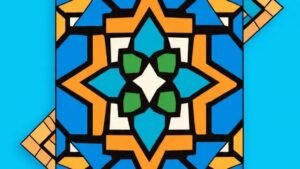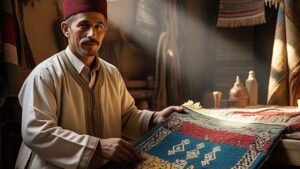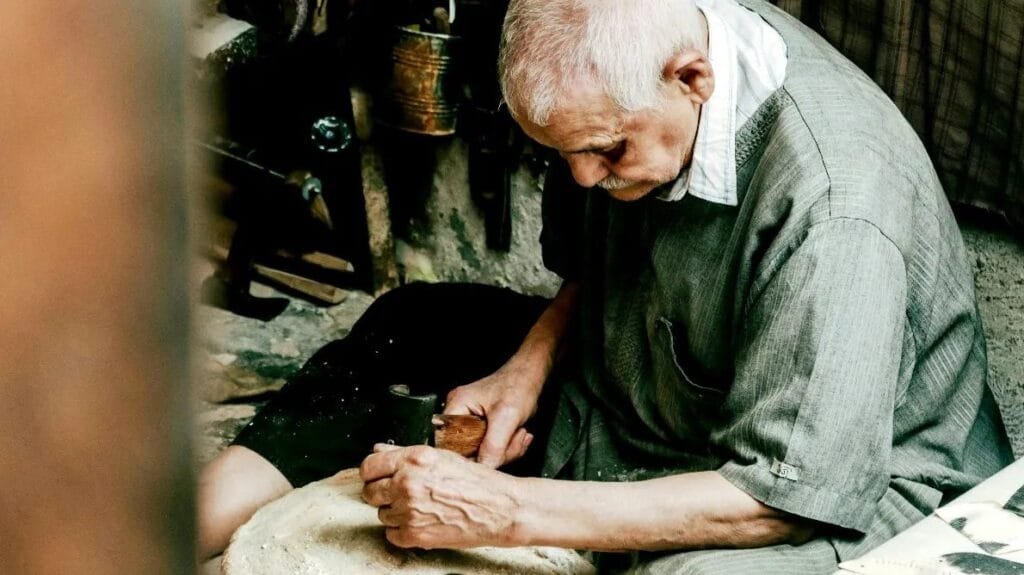
Endangered Moroccan crafts lie in the labyrinthine souks of Morocco, where the air hums with the scent of saffron and the echoes of haggling voices, revealing a world of artistry that has thrived for centuries. Yet, today, these crafts—woven into the very fabric of Moroccan identity—are fading into obscurity. From the delicate bone combs of Fez to the lustrous tadelakt plastering of Marrakech, these crafts whisper stories of a bygone era. Once the lifeblood of bustling medinas, they now teeter on the edge of extinction, threatened by modernity’s relentless march. To lose them would be to sever a vital thread connecting Morocco to its rich cultural tapestry.
1. Bone Combs: Fez’s Endangered Moroccan Crafts
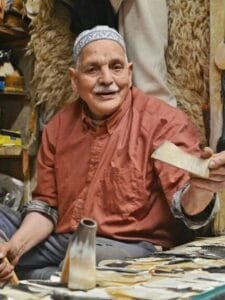
In the heart of Fez, where the ancient tanneries still dye leather in vibrant hues, another craft quietly endures: the making of bone combs, one of the endangered Moroccan crafts. For centuries, artisans have carved these intricate tools from camel or cow bone, their hands guided by traditions passed down through generations. Each comb, with its fine teeth and smooth edges, is a testament to patience and precision. Yet, today, only a handful of craftsmen remain, with some workshops reduced to a single master struggling against the tide of mass-produced plastic.
The process of crafting a bone comb is a labor of love. Artisans begin by selecting the finest bones, which are then boiled, cleaned, and cut into thin slabs. Using hand tools, they carve the teeth with meticulous care, ensuring each one is perfectly spaced. The final step involves polishing the comb to a silken finish, a process that can take hours. “Every comb tells a story,” says Mohamed, a master craftsman in his eighties. “But who will listen when the world has moved on?”
The decline of bone comb crafting is not just the loss of a functional object; it is the erosion of an endangered Moroccan craft and a cultural artifact. These combs were once prized wedding gifts, symbols of care and tradition. Today, they are relics of a slower, more deliberate way of life. As the last artisans age, their knowledge risks vanishing, leaving behind only the faintest trace of a craft that once defined Fez.
2. Tadelakt Plastering: The Lustrous Walls of Marrakech

In the ochre city of Marrakech, the art of tadelakt plastering has adorned palaces, hammams, and riads for centuries. This ancient technique, which produces a waterproof, luminous finish, is a hallmark of Moroccan architecture. Made from lime plaster and polished with river stones, tadelakt transforms walls into shimmering canvases, their surfaces rippling like water under the sun. Yet, despite its beauty, the craft is struggling to survive.
The process of creating tadelakt is both arduous and poetic, a perfect example of endangered Moroccan crafts that have been preserved over centuries. Artisans mix lime plaster with water and natural pigments, then apply it in layers to the wall. Once dry, they polish the surface with smooth stones, using olive oil soap to seal it. The result is a finish that glows with an almost ethereal light. “Tadelakt is not just plaster; it is alive,” explains Samir, a third-generation tadelakt artisan. “It breathes with the house, aging gracefully over time.”
Modern construction materials and techniques have pushed tadelakt to the margins. Synthetic alternatives, though cheaper and faster to apply, lack the soul and durability of the traditional craft. For the artisans who remain, each project is a labor of passion, a defiance against the tide of modernity. Yet, as demand dwindles, so too does the future of this luminous art.
3. Wool Felt: The Endangered Moroccan Crafts of the Atlas
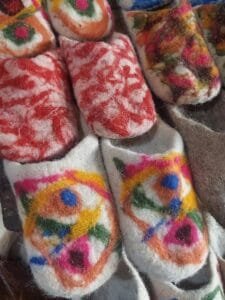
High in the Atlas Mountains, where the air is crisp and the landscape rugged, the Berber people have long practiced the art of wool felting. Using raw wool from local sheep, they create vibrant rugs, cloaks, and slippers, each piece imbued with the spirit of the mountains. The craft, passed down through generations, is a testament to resourcefulness and creativity. Yet, like many endangered Moroccan crafts, it faces an uncertain future.
The process of wool felting is both simple and profound. Artisans wash and card the wool, then layer it into intricate designs. Using hot water and soap, they agitate the fibers until they bind together, forming a dense, durable fabric. The final product is both functional and beautiful, a reflection of the Berber way of life. “Our slippers are like maps,” says Hammou, a Berber weaver. “They tell the story of our land and our people.”
Despite its cultural significance, wool felting is increasingly overshadowed by factory-made textiles. Younger generations, lured by the promise of urban life, are abandoning the craft, leaving elders to carry on alone. As the demand for handmade wool products declines, so too does the knowledge of this ancient art. Without intervention, the warmth of the Atlas Mountains may soon be lost to history.
4. Damascening: The Metallic Poetry of Meknes
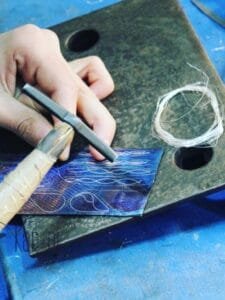
In the imperial city of Meknes, the art of damascening—decorating metal with intricate inlays of gold or silver—has flourished for centuries. This delicate craft, which originated in Damascus and found a home in Morocco, adorns everything from jewelry to weapons. Each piece is a masterpiece of precision, its patterns reflecting the artistry and patience of the maker. Yet, today, damascening is one of the most endangered Moroccan crafts, its future hanging by a thread.
The process of damascening is as demanding as it is beautiful. Artisans begin by etching a design into a metal surface, often steel or iron. Using fine tools, they hammer gold or silver wire into the grooves, creating a seamless inlay. The final step involves polishing the piece to a mirror-like finish, a process that can take weeks. “Damascening is not just decoration; it is a dialogue between metal and light,” says Ilyas, a master craftsman.
The decline of damascening is a loss not only for Morocco but for the world. This craft, which once adorned the courts of sultans and kings, is now relegated to a handful of workshops. As younger generations turn to more lucrative trades, the art risks disappearing entirely. Without a concerted effort to preserve endangered Moroccan crafts, the metallic poetry of Meknes may soon fall silent.
5. Amber Jewelry: Endangered Moroccan Crafts In Decline
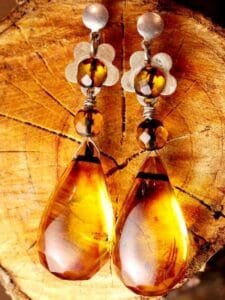
In the sun-drenched markets of southern Morocco, handcrafted amber jewelry glows like captured sunlight. This ancient craft, which transforms fossilized resin into wearable art, has been a symbol of beauty and protection for centuries. From intricate necklaces to delicate earrings, each piece tells a story of the Sahara’s golden sands. Yet, as with many endangered Moroccan crafts, the tradition is at risk of fading away.
The process of crafting amber jewelry is a blend of science and artistry. Artisans begin by selecting raw amber, often sourced from the Moroccan Sahara or imported from the Baltic. Using hand tools, they shape the resin into beads or pendants, polishing each piece to reveal its inner fire. The final step involves stringing the beads onto silk or silver, creating jewelry that shimmers with life. “Amber is not just a stone; it is a piece of history,” says Nisrine, a jeweler in Agadir.
The rise of synthetic materials and mass-produced jewelry has dealt a blow to this ancient craft. Younger artisans, faced with dwindling demand, are abandoning the trade in favor of more profitable ventures. As the last masters of amber jewelry age, their knowledge risks being lost forever. Without intervention, the golden tears of the Sahara may soon vanish from Morocco’s cultural landscape.
Conclusion: A Call to Remember
The endangered Moroccan crafts are more than mere objects; they are the soul of a nation. Each comb, each rug, each piece of jewelry carries within it the stories of countless artisans, their hands shaping beauty from raw materials. To lose these crafts is to lose a part of Morocco itself—a part that cannot be replaced.
Yet, there is hope. By celebrating and preserving these arts, we can ensure that they endure for generations to come. Let us not allow the whispers of the medinas to fade into silence. Let us remember the hands that carved, the hands that wove, the hands that polished. For in their work lies the essence of Morocco, a land where artistry and tradition are forever intertwined.

